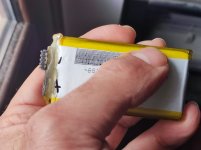- Joined
- Feb 9, 2023
- Messages
- 11
- Reaction score
- 1
I modified a Tello to accept the Mavic Air cell (LiPoHV, 2375mAh - 9,1Wh - 37gr) using the original Tello battery board.
I used an old (but still good) cell and got a runtime of about 8 minutes. Few.
So I bought some new cells (also to repair my Mavic Air batteries) and mounted one.
The maximum duration was 14 minutes, I can't go beyond that.
The weight of the "modified" drone is 90grams.
So I took another Tello with its original battery, ballasted it up to 90 grams (propeller guards and an additional 3g weight) and saw that it lasted 11 minutes.
WHY?
The weight is the same, but the Mavic's cell is MUCH bigger (and better) than the Tello's.
At the same weight (important) I expected a duration of at least 20 minutes, but it wasn't like this.
So I used a microcomputer to recharge the (empty) 5V batteries via the Tello's USB port (5V energy monitor)
With the original battery the Tello use an energy of 3.9Wh (the Tello battery is 4.18Wh, it's OK) while with the Mavic battery the Tello use an energy of 5.6Wh (But the Mavic cell is 9.1Wh!).
Therefore the Mavic cell is not fully discharged, but only partially. And it is "strangely" equal to the Tello's maximum autonomy with a new battery.
In my opinion the Tello's BMS (in the battery or in the aircraft) operates in such a way that the maximum duration is always 13-14 minutes.
That's why I once asked what could happen by connecting the cell directly to the Tello's 4-pin connector...
I used an old (but still good) cell and got a runtime of about 8 minutes. Few.
So I bought some new cells (also to repair my Mavic Air batteries) and mounted one.
The maximum duration was 14 minutes, I can't go beyond that.
The weight of the "modified" drone is 90grams.
So I took another Tello with its original battery, ballasted it up to 90 grams (propeller guards and an additional 3g weight) and saw that it lasted 11 minutes.
WHY?
The weight is the same, but the Mavic's cell is MUCH bigger (and better) than the Tello's.
At the same weight (important) I expected a duration of at least 20 minutes, but it wasn't like this.
So I used a microcomputer to recharge the (empty) 5V batteries via the Tello's USB port (5V energy monitor)
With the original battery the Tello use an energy of 3.9Wh (the Tello battery is 4.18Wh, it's OK) while with the Mavic battery the Tello use an energy of 5.6Wh (But the Mavic cell is 9.1Wh!).
Therefore the Mavic cell is not fully discharged, but only partially. And it is "strangely" equal to the Tello's maximum autonomy with a new battery.
In my opinion the Tello's BMS (in the battery or in the aircraft) operates in such a way that the maximum duration is always 13-14 minutes.
That's why I once asked what could happen by connecting the cell directly to the Tello's 4-pin connector...
Last edited:


